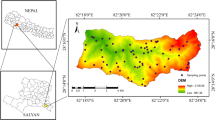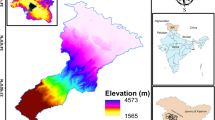Abstract
This work aims at the assessment of soil erosion rate and its spatial distribution in hilly mountainous Nisava River Basin (South-eastern Serbia) with a surface area of approximately 2,848 km2. The study was conducted using Universal Soil Loss Equation (USLE) model due to its modest data demand and easy comprehensible structure. The erosion factors of USLE were collected and processed through a GIS-based approach. Landsat 7 Enhanced Thematic Mapper (ETM+) image and normalized difference vegetation index (NDVI) were used for the determination of crop management factor. The average annual soil loss was estimated at 27.0 t ha−1 year−1 classifying Nisava River Basin under very high erosion rate category. About 39.0 % of the watershed area was characterized by slight erosion rate (<5 t ha−1 year−1), 7.7 % of the area was found to be under moderate erosion rate (5–10 t ha−1), 13.8 % of the area is under high erosion rate (10–20 t ha−1), while around 17.5 % of the area was under very high erosion rate (20–40 t ha−1 year−1). Severe erosion rate (40–80 t ha−1 year−1) was observed at 14.2 % of the study area, whereas very severe erosion rate (>80 t ha−1 year−1) described about 7.8 % of the watershed. The results of this work are in agreement with the soil erosion map of Serbia, the sediment yield measurements in the basin and with other, more detailed, studies in the watershed. Therefore, the presented methodology could be applied as a framework for the evaluation of erosion factors on soil resources in South-eastern Serbia when limited data are available. The outputs of these studies can be used for the identification of vulnerable areas on a cell basis and for planning of conservation practices.







Similar content being viewed by others
References
Baskan O, Cebel H, Akgul S, Erpul G (2010) Conditional simulation of USLE/RUSLE soil erodibility factor by geostatistics in a Mediterranean Catchment, Turkey. Environ Earth Sci 60:1179–1187. doi:10.1007/s12665-009-0259-2
Buishand TA, Beersma JJ, Sluiter R, Kroon T (2008) Definitiestudie rasterdata meteorologie. De Bilt, KNMI/RWS Waterdienst (http://www.knmi.nl/publications/fulltexts/definitiestudie_rasterdatav7.pdf)
Buttafuoco G, Conforti M, Aucelli PPC, Robustelli G, Scarciglia F (2011) Assessing spatial uncertainty in mapping soil erodibility factor using geostatistical stochastic simulation. Environ Earth Sci. doi:10.1007/s12665-011-1317-0 (published online 27 August 2011)
Chen T, Niu R-q, Li P-x, Zhang L-p, Du B (2011) Regional soil erosion risk mapping using RUSLE, GIS, and remote sensing: a case study in Miyun Watershed, North China. Environ Earth Sci 63:533–541. doi:10.1007/s12665-010-0715-z
CORINE (1992) Soil erosion risk and important land resources in the Southern Regions of the European Community. EUR 13233. Office for Official Publications of the European Communities, Luxembourg
Dabral PP, Baithuri N, Pandey A (2008) Soil erosion assessment in a hilly catchment of North Eastern India using USLE, GIS and remote sensing. Water Resour Manag 22:1783–1798. doi:10.1007/s11269-008-9253-9
De Jong SM, Riezebos HT (1997) SEMMED: a distributed approach to soil erosion modelling. In: Spiteri A (ed) Remote sensing’96: integrated applications for risk assessment and disaster prevention for the Mediterranean. Balkema, Rotterdam, pp 199–204
De Jong SM, Paracchini ML, Bertolo F, Folving S, Megier J, De Roo APJ (1999) Regional assessment of soil erosion using the distributed model SEMMED and remotely sensed data. Catena 37(3-4):291–308. doi:10.1016/S0341-8162(99)00038-7
Demirci A, Karaburun A (2011) Estimation of soil erosion using RUSLE in a GIS framework: a case study in the Buyukcekmece Lake watershed, northwest Turkey Environ Earth Sci. doi:10.1007/s12665-011-1300-9 (published online 23 August 2011)
Desmet PJ, Govers G (1996) A GIS-procedure for the automated calculation of the USLE LS-factor on topographically complex landscape units. J Soil Water Conserv 51(5):427–433 (http://www.jswconline.org/content/51/5/427.full.pdf+html)
Fistikoglu O, Harmancioglu NB (2002) Integration of GIS with USLE in assessment of soil erosion. Water Resour Manag 16:447–467. doi:10.1023/A:1022282125760
Foster GR, Lane LJ, Nowlin JD, Laflen JM, Young RA (1980) A model to estimate sediment yield from field-sized areas: development of model. In: Knisel WG (ed) CREAMS: a field scale model for chemicals, runoff, and erosion from Agricultural Management Systems, US Dept. of Agric., Sci. and Educ. Admin., Conser. Rep. No. 26, pp 36–64
Garbrecht J, Martz LW (1999) Digital elevation model issues in water resources modeling. In: Proceedings of the 19th Esri users conference, San Diego, CA. (http://proceedings.esri.com/library/userconf/proc99/proceed/papers/pap866/p866.htm)
Griffin ML, Beasley DB, Fletcher JJ and Foster GR (1988) Estimating soil loss on topographically nonuniform field and farm units. J Soil Water Conserv 43:326–331 (http://www.jswconline.org/content/43/4/326.full.pdf+html)
Hickey R, Smith A, Jankowski P (1994) Slope length calculations from a DEM within Arc/Info GRID. Comput Environ Urban 18(5):365–380. doi:10.1016/0198-9715(94)90017-5
Irvem A, Topaloglu F, Uygur V (2007) Estimating spatial distribution of soil loss over Seyhan River Basin in Turkey. J Hydrol 336:30–37. doi:10.1016/j.jhydrol.2006.12.009
IUSS Working Group WRB (2006) World reference base for soil resources 2006. World Soil Resources Reports no. 103. FAO, Rome (ISBN 92-5-105511-4)
Jensen JR (2000) Remote sensing of the environment: an earth resource perspective. Prentice Hall, New Jersey
Jurgens C, Fander M (1993) Soil erosion assessment and simulation by means of SGEOS and ancillary digital data. Int J Remote Sens 14(15):2847–2855. doi:10.1080/01431169308904313
Kim JB, Saunders P, Finn JT (2005) Rapid assessment of soil erosion in the Rio Lempa Basin, Central America, using the Universal Soil Loss Equation and geographic information systems. Environ Manag 36(6):872–885. doi:10.1007/s00267-002-0065-z
Kostadinov S (2003) Erozija u slivu Visočice. Erozija, 30 69–76
Kouli M, Soupios P (2009) Soil erosion prediction using the revised Universal Soil Loss Equation (RUSLE) in a GIS framework, Chania, Northwestern Crete, Greece. Environ Geol 57:483–497. doi:10.1007/s00254-008-1318-9
Krishna Bahadur KC (2009) Mapping soil erosion susceptibility using remote sensing and GIS: a case of the Upper Nam Wa Watershed, Nan Province, Thailand. Environ Geol 57:695–705. doi:10.1007/s00254-008-1348-3
Lazarevic R (1983) Karta erozije SR Srbije 1:500.000. Institut za šumarstvo i drvnu industriju, Beograd
Lee S (2004) Soil erosion assessment and its verification using the Universal Soil Loss Equation and geographic information system: a case study at Boun, Korea. Environ Geol 45(4):457–465. doi:10.1007/s00254-003-0897-8
Lu D, Li G, Valladares GS, Batistella M (2004) Mapping soil erosion risk in Rondonia, Brazilian Amazonia: using RUSLE, remote sensing and GIS. Land Degrad Dev 15(5):499–512. doi:10.1002/ldr.634
Ma JW, Xue Y, Ma CF, Wang ZG (2003) A data fusion approach for soil erosion monitoring in the Upper Yangtze River Basin of China based on Universal Soil Loss Equation (USLE) model. Int J Remote Sens 24(23):4777–4789. doi:10.1080/0143116021000056028
Mati BM, Veihe A (2001) Application of the USLE in a savannah environment: comparative experiences from East and West Africa. Singap J Trop Geogr 22(2):138–155. doi:10.1111/1467-9493.00099
Mhangara P, Kakembo V, Lim KJ (2011) Soil erosion risk assessment of the Keiskamma catchment, South Africa using GIS and remote sensing. Environ Earth Sci. doi:10.1007/s12665-011-1190-x (published online 21 July 2011)
Mihara M, Yamamoto N, Ueno T (2005) Application of USLE for the prediction of nutrient losses in soil erosion processes. Paddy Water Environ 3:111–119. doi:10.1007/s10333-005-0006-6
Millward AA, Mersey JE (1999) Adapting the RUSLE to model soil erosion potential in a mountainous tropical watershed. Catena 38(2):109–129. doi:10.1016/S0341-8162(99)00067-3
Mitasova H, Hofierka J, Zlocha M, Iverson L (1996) Modelling topographic potential for erosion and deposition using GIS. Int J GIS 10(5):629–641. doi:10.1080/02693799608902101
Moore I, Burch G (1986) Physical basis of the length-slope factor in the Universal Soil Loss Equation. Soil Sci Soc Am J 50(5):1294–1298. doi:10.2136/sssaj1986.5051294x
Moore ID, Wilson JP (1992) Length–slope factors for the revised universal soil loss equation: simplified method of estimation. J Soil Water Conserv 47(5):423–428 (http://www.jswconline.org/content/47/5/423.full.pdf+html)
Morgan RPC, Quinton JN, Smith RE, Govers G, Poesen JWA, Auerswald K, Chisci G, Torri D, Styczen ME (1998) The European soil erosion model (EUROSEM): a dynamic approach for predicting sediment transport from fields and small catchments. Earth Surf Proc Land 23:527–544. doi:10.1002/(SICI)1096-9837(199806
Mustafić S, Kostadinov S, Manojlović P (2008). Risk of artificial lake “Zavoj” to processes of erosion—methodological, knowing and protecting aspect. Bulletin of the Serbian Geographical Society, Year 2008 Tome LXXXVIII, no 1 UDC 911.2:551.053(497.11)
Nearing MA (1997) A single, continuous function for slope steepness influence on soil loss. Soil Sci Soc Am J 61(3):917–919. doi:10.2136/sssaj1997.613917x
Nearing MA, Foster GR, Lane LJ, Finkner SC (1989) A process-based soil erosion model for USDA-water erosion prediction project technology. T ASAE 32(5):1587–1593 (http://www.tucson.ars.ag.gov/unit/publications/PDFfiles/846.pdf)
Pandey A, Mathur A, Mishra SK, Mal BC (2009) Soil erosion modeling of a Himalayan watershed using RS and GIS. Environ Earth Sci 59:399–410. doi:10.1007/s12665-009-0038-0
Perry M, Hollis D (2005) The generation of monthly gridded datasets for a range of climatic variables over the UK. Int J Climatol 25:1041–1054. doi:10.1002/joc.1161
Prasannakumar V, Shiny R, Geetha N, Vijith H (2011) Spatial prediction of soil erosion risk by remote sensing, GIS and RUSLE approach: a case study of Siruvani River watershed in Attapady Valley, Kerala. India. Environ Earth Sci 64:965–972. doi:10.1007/s12665-011-0913-3
Renard KG, Foster GR, Weesies GA (1991) RUSLE: revised universal soil loss equation. J Soil Water Conserv 46(1):30–33 (http://www.jswconline.org/content/46/1/30.full.pdf+html)
Renard KG, Foster GR, Weesies GA, McCool DK, Yoder DC (1997) Predicting soil erosion by water: a guide to conservation planning with the revised universal soil loss equation. Agricultural Handbook, vol 703, US Department of Agriculture
Schmidt J, Werner MV, Michael A (1999) Application of the EROSION 3D model to the Catsop watershed, The Netherlands. CATENA 37(3–4):449–456. doi:10.1016/S0341-8162(99)00032-6
Shepard D (1968) A two-dimensional interpolation function for irregularly-spaced data. In: Proc. 23rd national conference ACM, ACM, pp 517–524
Sivertun A, Prange L (2003) Non-point source critical area analysis in the Gisselo watershed using GIS. Environ Modell Softw 18:887–898. doi:10.1016/S1364-8152(03)00107-5
Smith SJ, Williams JR, Menzel RG, Coleman GA (1984) Prediction of sediment yield from Southern Plains grasslands with the modified universal soil loss equation. J Range Manag 37(4):295–297 (http://www.jstor.org/stable/3898697)
Van der Knijff J, Jones RJA, Montanarella L (2000) Soil erosion risk assessment in Italy. European Soil Bureau, Joint Research Center of European Commission. EUR 19022EN (http://eusoils.jrc.ec.europa.eu/esdb_archive/pesera/pesera_cd/pdf/ItalyErosValidation.pdf)
Wang B, Liu GB, Xue S, Zhu B (2011) Changes in soil physico-chemical and microbiological properties during natural succession on abandoned farmland in the Loess Plateau. Environ Earth Sci 62:915–925. doi:10.1007/s12665-010-0577-4
Wang B, Liu G, Xue S (2012) Effect of black locust (Robinia pseudoacacia) on soil chemical and microbiological properties in the eroded hilly area of China’s Loess Plateau. Environ Earth Sci 65:597–607. doi:10.1007/s12665-011-1107-8
Wischmeier WH, Smith DD (1978) Predicting rainfall erosion loss: a guide to conservation planning. Agricultural Handbook No. 537, US Department of Agriculture, Agricultural Research Service, Washington, DC
Zhang Q-f, Wang L, Wu F-q (2008) GIS-based assessment of soil erosion at Nihe Gou Catchment. Agric Sci China 7(6):746–753. doi:10.1016/S1671-2927(08)60110-8
Zhou P, Luukkanen O, Tokola T, Nieminen J (2008) Effect of vegetation cover on soil erosion in a mountainous watershed. Catena 75(2008):319–325. doi:10.1016/j.catena.2008.07.010
Acknowledgments
This paper was realized as a part of two projects: “Studying climate change and its influence on the environment: impacts, adaptation and mitigation” (43007) and “Impact of soil quality and irrigation water quality on agricultural production and environmental protection” (37006) financed by the Ministry of Education and Science of the Republic of Serbia for the period 2011–2014.
Author information
Authors and Affiliations
Corresponding author
Rights and permissions
About this article
Cite this article
Perović, V., Životić, L., Kadović, R. et al. Spatial modelling of soil erosion potential in a mountainous watershed of South-eastern Serbia. Environ Earth Sci 68, 115–128 (2013). https://doi.org/10.1007/s12665-012-1720-1
Received:
Accepted:
Published:
Issue Date:
DOI: https://doi.org/10.1007/s12665-012-1720-1




